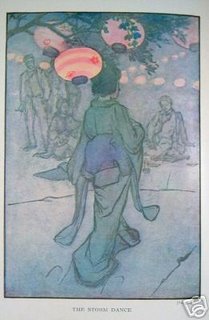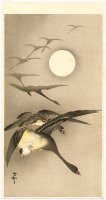a tale of three harvests
Labels: bruce rogers, camille martin, Utamaro Kitagawa




Labels: genjiro ito, henri boutet, poetry, shotei hiroaki, toulouse-lautrec, walt whitman
 well, i'm sure that any student of history is used to conflicting stories, but this is my first real foray, so i'm surprised, interested, and maybe even amused. this print from a manga is by hishikawa moronobu. it was done in 1683. this suggests to me that in fact peacocks did indeed exist in japan. now there could be a million reasons why i'm wrong: he made these up and just coincidentally re-created a real bird; they were there but died out by the time iida made that kimono; and ad absurdum. more likely, i guess, the person who reported that fact (someone from the kyoto costume institute?) was misinformed. there must be a story but we just may never get it. (oh--i just noticed--this must be from the same series.)
well, i'm sure that any student of history is used to conflicting stories, but this is my first real foray, so i'm surprised, interested, and maybe even amused. this print from a manga is by hishikawa moronobu. it was done in 1683. this suggests to me that in fact peacocks did indeed exist in japan. now there could be a million reasons why i'm wrong: he made these up and just coincidentally re-created a real bird; they were there but died out by the time iida made that kimono; and ad absurdum. more likely, i guess, the person who reported that fact (someone from the kyoto costume institute?) was misinformed. there must be a story but we just may never get it. (oh--i just noticed--this must be from the same series.)Labels: hishikawa moronobu
 Woman's dressing gown in two parts
Woman's dressing gown in two partsKyoto, Japan
Gown (center back length): 141.0 cm (55 1/2 in.); sash (overall) 33.0 x 301.0 cm (13 x 118 1/2 in.)
Silk plain weave (taffeta) embroidered with polychrome silk; silk plain weave lining; cord and tassel trim
Classification: Costumes
Pink silk taffeta dressing gown in kimono style with embroidered naturalistic chrysanthemums and butterflies in polychrome silks. Silk plain weave lining, padded hem and pleat in back of robe. Full sleeves gathered at shoulders and trimmed with braided silk cord and tassles. Matching sash of pink silk taffeta with double-sided embroidery of chrysanthemums in green brown and pink polychrome silk with knotted silk fringe. Gown labeled: S. Iida "Takashimaya" Silks and Embroideries. Kyoto.
Labels: chrysanthemums, fashion, Iida Takashimaya
 (hokusai; unknown japanese ceremonial fabric cover, 19th century; habert-dys, french ca. 1900)
(hokusai; unknown japanese ceremonial fabric cover, 19th century; habert-dys, french ca. 1900)

Labels: habert-dys, hokusai
 in his work, art and art industries in japan (1878), rutherford alcock singles out the love of nature and partiality towards the ever changing state of things to be characteristic of japanese art: nature being neither uniform nor repetitive, learning from it can result in a rich diversity, and this learning process from nature accounts for those characteristics of japanese art which are lacking in european art.
in his work, art and art industries in japan (1878), rutherford alcock singles out the love of nature and partiality towards the ever changing state of things to be characteristic of japanese art: nature being neither uniform nor repetitive, learning from it can result in a rich diversity, and this learning process from nature accounts for those characteristics of japanese art which are lacking in european art.

Labels: decorchemont, ephraim faience, genki raian
 in 1863 critic william rosetti offered advice to western artists regarding their japanese counter- parts. "study their practice," he said, "for such points as the actions of birds, their quaint turns of head or lithe deviations of neck; the decorative and at the same time naturalistic treatment of plumage... we incline to say that the japanese reach higher in point of perceptive knowledge, and instant magic of the realizing hand, than any phase or period of european art..." (illustration by felix lorioux)
in 1863 critic william rosetti offered advice to western artists regarding their japanese counter- parts. "study their practice," he said, "for such points as the actions of birds, their quaint turns of head or lithe deviations of neck; the decorative and at the same time naturalistic treatment of plumage... we incline to say that the japanese reach higher in point of perceptive knowledge, and instant magic of the realizing hand, than any phase or period of european art..." (illustration by felix lorioux)Labels: felix lorioux
 The speaker of this poem, "Summer Birds and Flowers," is someone looking at a scroll by Shikibu Terutada from the sixteenth century.
The speaker of this poem, "Summer Birds and Flowers," is someone looking at a scroll by Shikibu Terutada from the sixteenth century.Unrolling
the coiled scroll
enacts the momentary
sweeping down the midday sky
of small birds
on a draft from the distant
 blue ravines
blue ravines and impends
and impends
is tempered—
so that the tidal and jagged line
of the far mountains
seems merely an artful
 mapping of the birds'
mapping of the birds'
arc of flight
And such a glimmer of gaiety
as they dip and swoop
with unguarded ease
into the inseparable
immensity
(from 'autumn grasses')

Labels: birds, bracquemond, hokusai, margaret gibson, ohara koson, poetry, theo van hoytema
 henri riviere's "les trente-six vues de la tour eiffel" is in exhibition at the new otani art museum in tokyo until Oct. 22.
henri riviere's "les trente-six vues de la tour eiffel" is in exhibition at the new otani art museum in tokyo until Oct. 22.
Labels: 36 views, henri riviere, hiroshige ando, hokusai
 jules auguste habert-dys's japonisme, for reasons i don't understand, appeals to me in some deeply personal way. it feels quintessential, a superb distilling of french and japanese. i can find very little about him other than that he was just one of many artists who came out with a collection of designs at the turn of the last century, and that he studied with felix bracquemond, and illustrated for one of the many "art and decor" magazines popular at the time.
jules auguste habert-dys's japonisme, for reasons i don't understand, appeals to me in some deeply personal way. it feels quintessential, a superb distilling of french and japanese. i can find very little about him other than that he was just one of many artists who came out with a collection of designs at the turn of the last century, and that he studied with felix bracquemond, and illustrated for one of the many "art and decor" magazines popular at the time.Labels: habert-dys, ohara koson